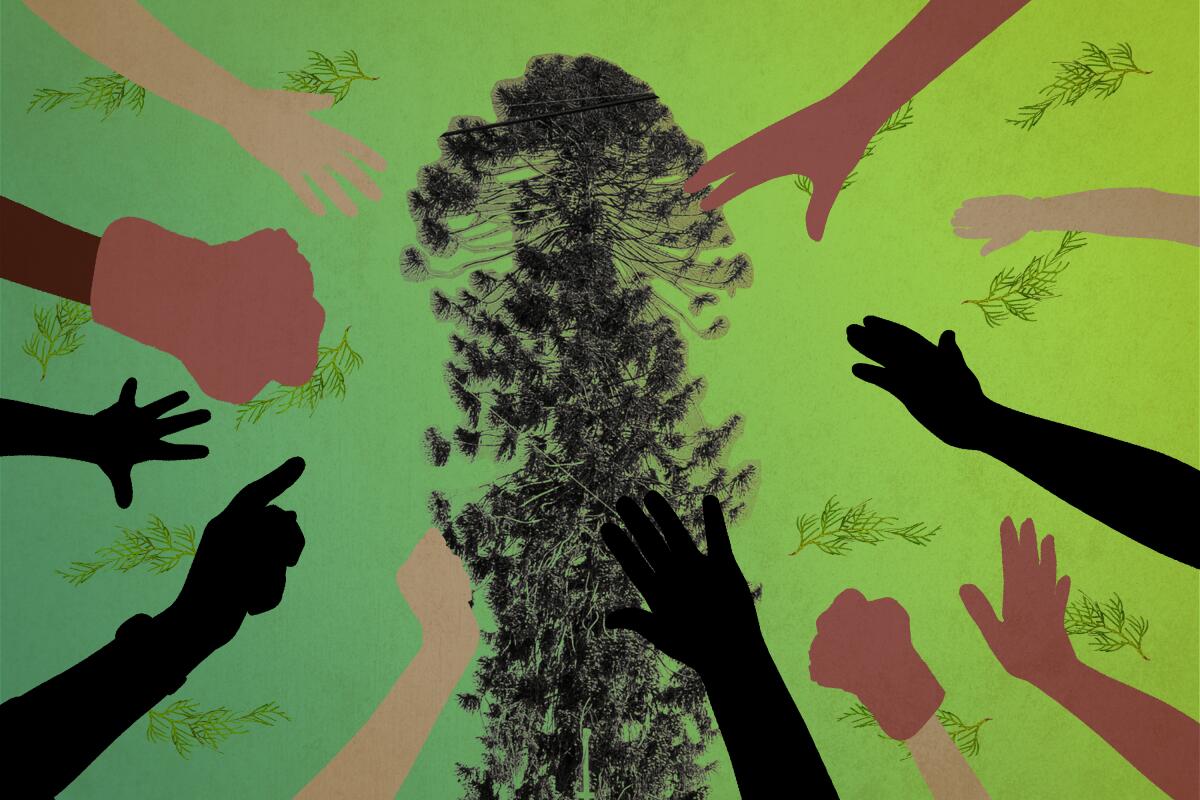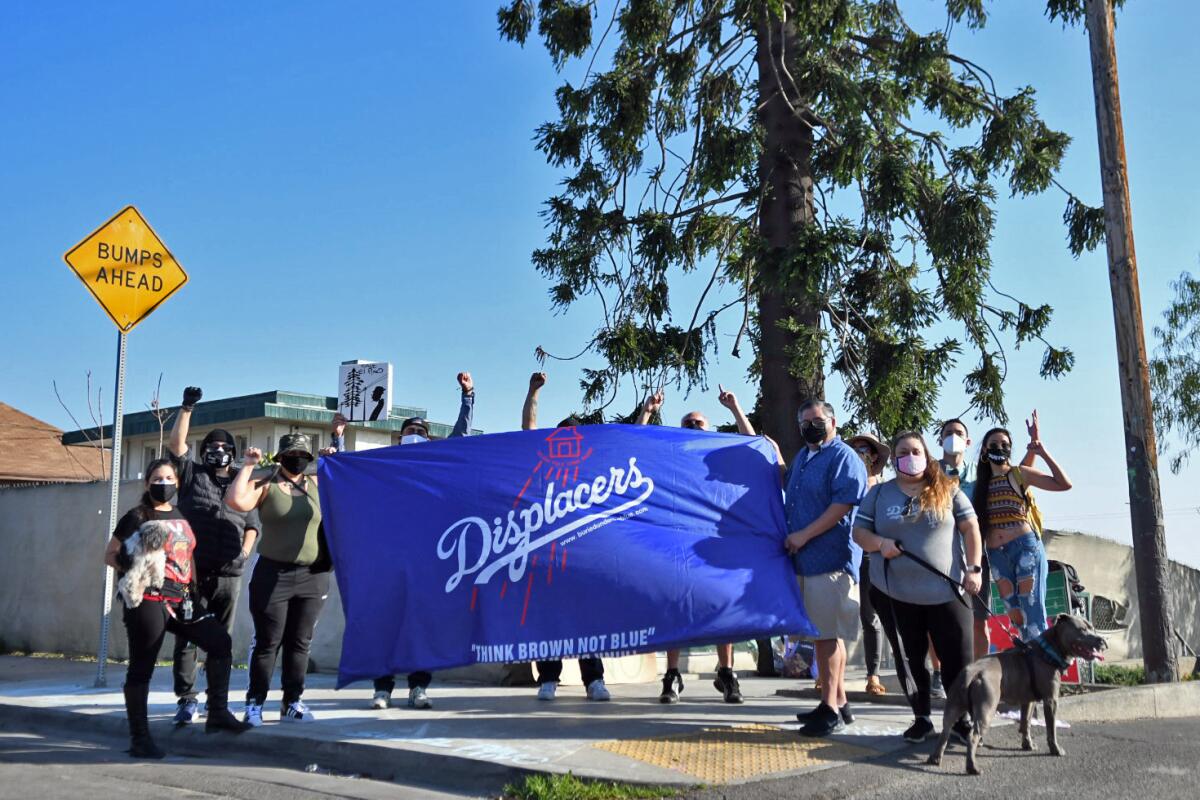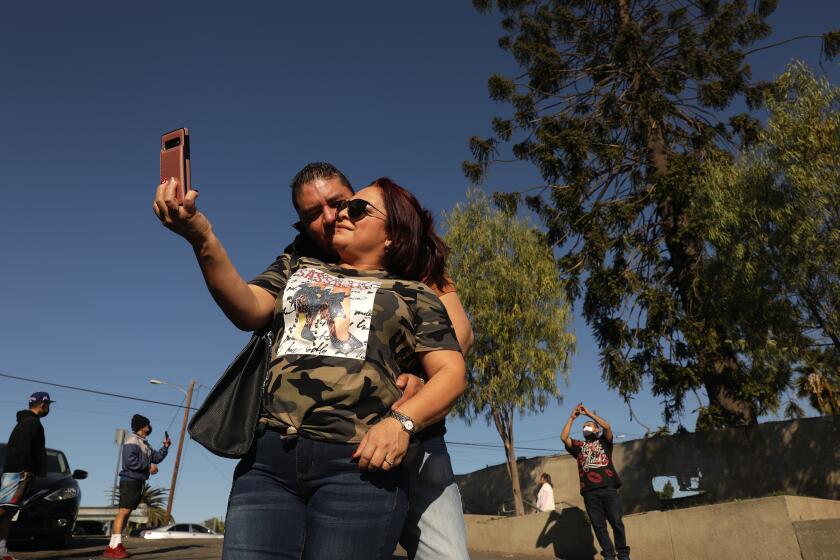Why East L.A. community members still worry about the future of a beloved tree

Every Sunday at 2 p.m., a group of community members meets (in a socially distanced manner) on the corner of Folsom and Indiana streets, near the invisible boundary between East Los Angeles and Boyle Heights, to discuss the future of a bunya pine tree.
The tree — El Pino, as it’s affectionately known by the community — is well known for its role in the 1993 crime drama “Blood In, Blood Out,” but to the people of East L.A. it has more communal significance than international recognition. This is where people come together.
Miguel Paredes, an organizer who was born in East L.A. and grew up in Elysian Valley, says El Pino is “the symbol of this community.” East L.A. native Michael Lopez, a roofer and videographer, says the tree is “more of a sign of love” than merely a movie star.

Paredes and Lopez started coming here Jan. 3, when hundreds turned out — in lowriders and on foot — to show their support for El Pino. They fear for the health of the tree — and for what it represents in the fight against gentrification in East L.A.
El Pino sits on a lot that has, for the past five years, been owned by a developer, Art Gastelum, who, despite stating that he won’t cut down the beloved tree, plans to build a duplex around it. Community organizers fear that the development will harm the tree’s delicate root structure, and say that Gastelum should donate the plot back to the community (noting that it could qualify as a tax deduction) or sell it back to the county for its fair market value.
Until that happens, organizers plan to keep showing up every week.
A prank galvanizes a community
Back on Dec. 28 — a prank holiday known as Día de los Inocentes — a rumor spread on a “Blood In, Blood Out” fan page, claiming that Gastelum planned to chop down the tree. The rumor was false, but it ignited a grassroots upheaval to “save” the tree. A petition to County Supervisor Hilda Solis circulated quickly, amassing almost 16,000 signatures asking the politician to “save El Pino from being cut down.”
Four days after the Día de los Inocentes prank, Gastelum told The Times, “I never want anything to happen to that tree. ... It’s almost like a little treasure for us.” But organizers weren’t swayed by his pleas. “There’s nobody on God’s green Earth that can convince me that somehow building two huge buildings next to a poor tree is going to somehow quote unquote, ‘save the Pino,’” Paredes said.
An oddly shaped tree became the breakout star of the cult movie “Blood In, Blood Out.” A Facebook post caused its legions of fans to worry it was going to be chopped down.
This lack of trust is grounded in a history of development on the Eastside that has uprooted the largely Mexican American working class in the area. The Argueta-Mejia family has owned a home in the neighborhood — on Folsom Street, near the intersection where El Pino towers — since 2009. Two of their three children were born in the house. Elisa Mejia, 50, teaches English as a second language in Highland Park, where she’s lost students to soaring rents. (At one point, the tenants rights group Inquilinos Unidos visited her class to talk about renters’ rights.) Her husband, Rodrigo Argueta, 55, mentioned the rising rents in Boyle Heights that squeezed mariachis out of Mariachi Plaza.
They’ve seen firsthand gentrification’s effect on the neighborhood.
Argueta views El Pino as a symbol of East Los Angeles’ resistance against gentrification — even if the developer argues that the project is for the community.
“It’s always saying that it’s for the community. ‘All these new apartments, we’re going to have so much areas for the neighbors, the people right here, they can rent it,’” Argueta said. “And at the end, what happens? Nobody can afford it.”
Gastelum, who has been investigated by the FBI in corruption probes, grew up on Winter Street and Ditman Avenue as a child, just blocks from El Pino, and attended Malabar Elementary School (across from the tree) and the nearby Belvedere Middle School.
“They couldn’t find a better steward for that tree than me,” Gastelum told The Times. “Because I have the money, I have the resources to maintain it. And I have a love for it because I came from that community.”
He hopes the two single-family homes he plans to build will attract young executives to the community. Several people have expressed interest, he said, including a young lawyer, a young architect and an artist.
“There’s a lot of young professionals that can easily afford a rent of a new home like that, but guess what? You try to find me a home in Boyle Heights,” Gastelum said. “You’re not going to find them. There’s a handful.”
That’s exactly what Roberto Garcia-Ceballos, program manager at Fideicomiso Comunitario Tierra Libre, a community land trust in East L.A. and Boyle Heights, is worried about. Even so-called affordable housing — defined by the Department of Housing and Urban Development as costing 30% or less of residents’ income — can be inaccessible to the working class in East L.A., Garcia-Ceballos pointed out.
But if Gastelum asks for market-rate rent, that could easily price out East L.A. residents, whose median income in 2018 was $41,193 — 40% lower than Los Angeles County’s median income. Garcia-Ceballos would rather see the plot become genuinely affordable housing for low-income residents, or a park, like community residents are asking for, he said.
“Those folks should be prioritized,” Garcia-Ceballos said. “Versus fixing things by moving new populations in or trying to increase the income by bringing people with higher incomes. That’s really unfair, because it just completely invisible-izes the folks who have been here.”
Lopez, for his part, favors a public green space. Before his father died, they used to walk together around El Pino on Saturday mornings. “I want to take my son as well to El Pino,” Lopez said. “I take him here every [so] often, but I want to be able for him to roam around in that park, and have his memories of me taking him how I had my memories of my dad and myself.”
Since December, organizers have been hard at work developing alternatives. A survey that the group put together asks: “Should El Pino be declared a historic landmark? Should the public have access to El Pino?” and “Would you rather see this area around El Pino become a public space?” with suggestions such as “community garden,” “dog park” and “playground” listed below.
Community input is a necessary, democratic first step toward preservation. The problem with development is that it doesn’t always match the neighborhood’s needs.
“Gentrification could mean that people start their own businesses,” Mejia said. “But … there’s a component to that, that means people are left out. And they don’t have a piece of that pie. And the rents go so high that they can’t even live in their own community. And that’s the kind of gentrification that hurts our people.”
More to Read
Sign up for our L.A. Times Plants newsletter
At the start of each month, get a roundup of upcoming plant-related activities and events in Southern California, along with links to tips and articles you may have missed.
You may occasionally receive promotional content from the Los Angeles Times.








